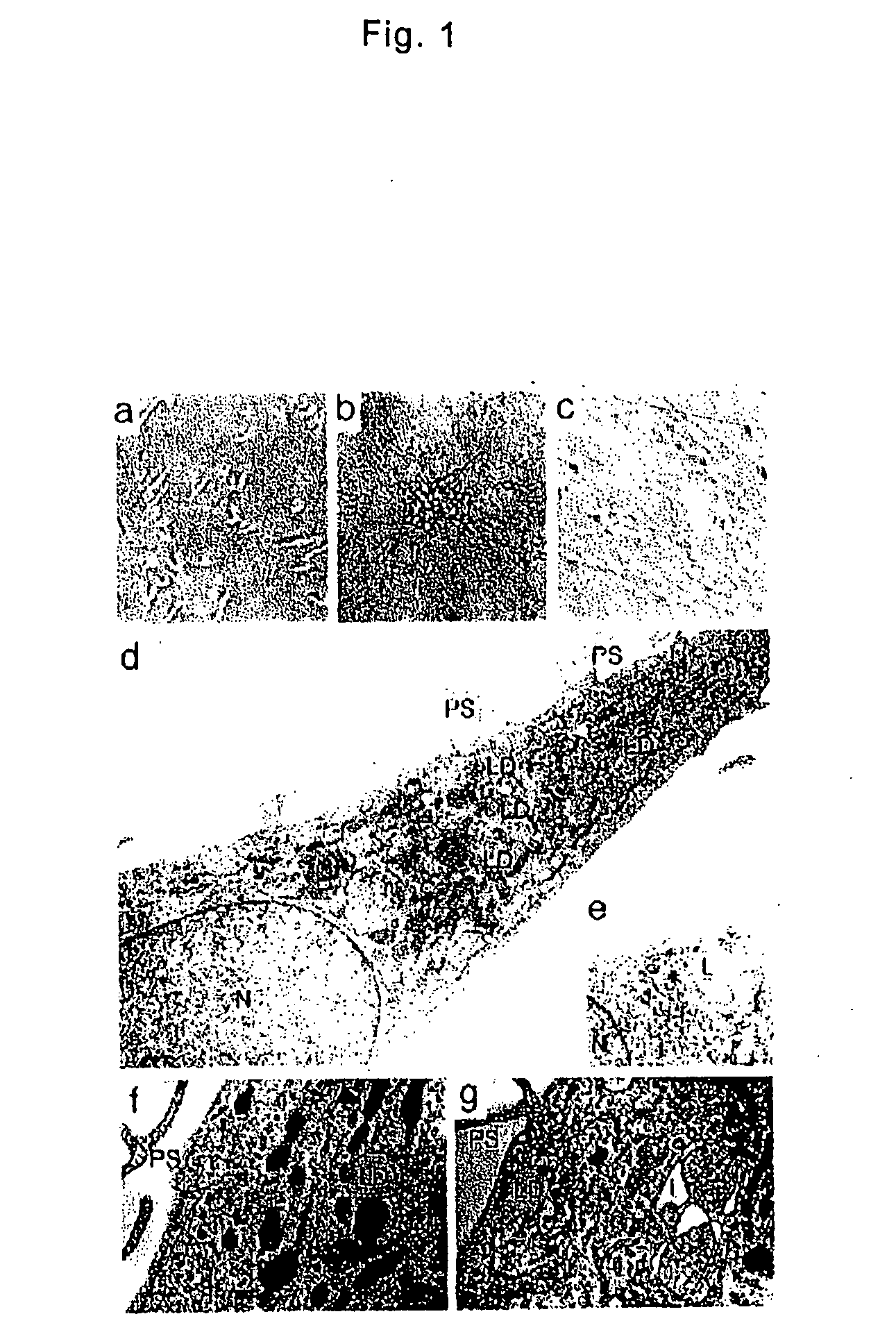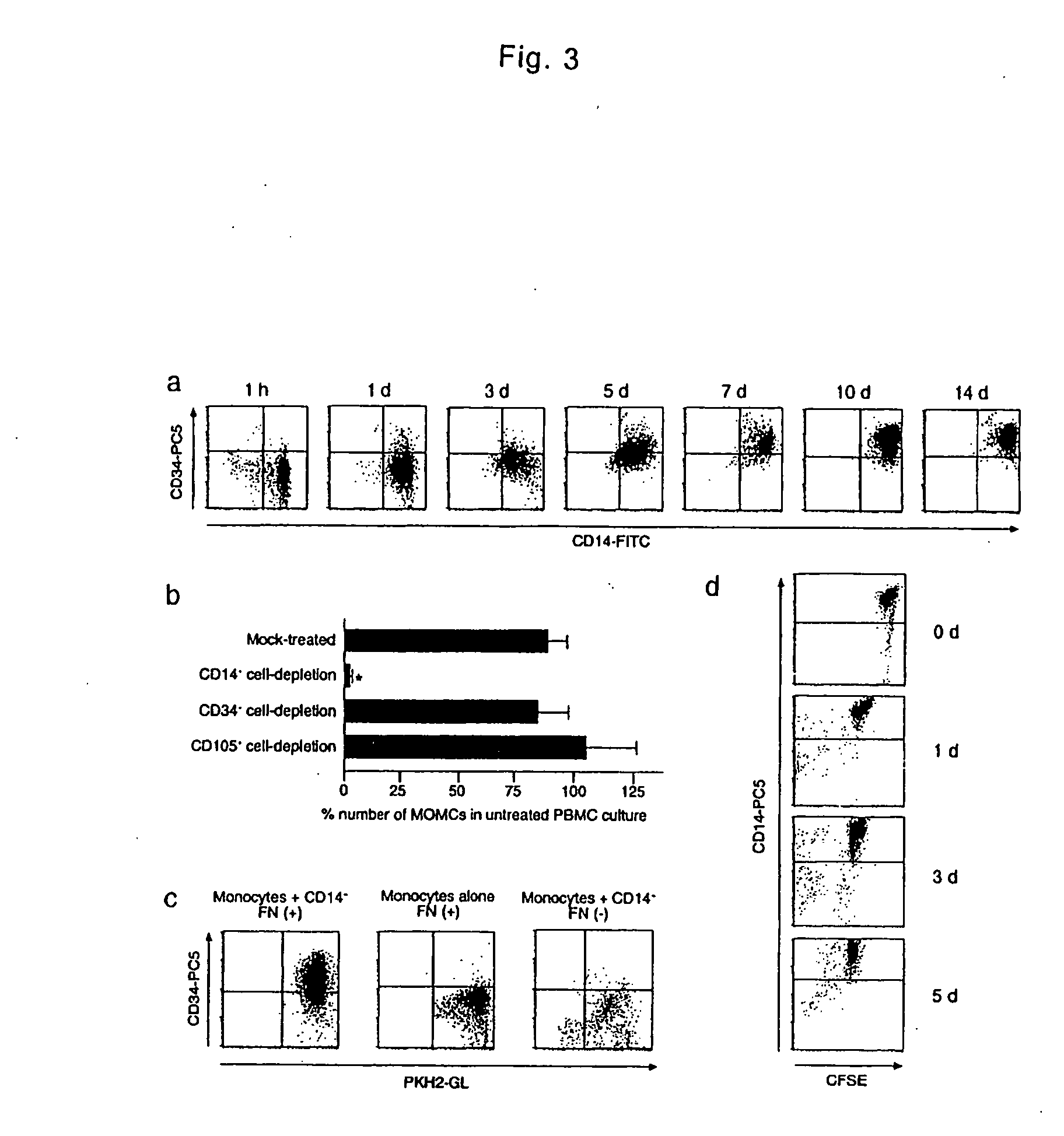Monocyte-origin multipotent cell momc
- Summary
- Abstract
- Description
- Claims
- Application Information
AI Technical Summary
Benefits of technology
Problems solved by technology
Method used
Image
Examples
example 1
MOMC Cultures
[0034] PMBCs were isolated from heparinized venous blood obtained from healthy adult by Lymphoprep (Nycomed Pharma AS) density gradient centrifugation. All blood samples were obtained after the subjects gave their written informed consent, approved by the Institutional Review Boards. Isolated cells were washed twice with phosphate-buffered saline (PBS) and suspended in low-glucose DMEM supplemented with 10% heat-inactivated FBS (JRH Biosciences). PMBCs were cultured at a density of 2×106 / ml on plastic plates coated with fibronectin without any additional growth factors at 37° C. with 5% CO2, in a humidified atmosphere. Three days after the culture, non-adherent cells were removed. The medium was changed to a fresh one every three days and the cells were cultured for up to 4 weeks. After 7-10 days of culture, the adherent cells were collected as MOMCs and used in the following assays or were moved on new fibronectin-coated plates and maintained in the same culture condi...
example 2
Preparation of Macrophages and Dendritic Cells
[0037] Macrophages were prepared by culturing adherent PMBCs on plastic plates in M199 medium supplemented with 20% FBS and 4 ng / ml M-CSF (R&D Systems) for 7 days (Differentiation, 65, 287-300, 2000). Mature monocyte-derived dendritic cells were obtained from plastic adherent PBMCs by maturation using a series of culture conditions (J Immunol Methods, 196, 121-135, 1996). Briefly, adherent cells were cultured in RPMI1640 supplemented with 10% FBS containing 50 ng / ml GM-CSF and 50 ng / ml IL-4 (all from PeproTech) for 7 days. Next, the immature dendritic cells were incubated with 50 ng / ml TNF-α (PeproTech) for 3 days. Flow cytometric analysis revealed that the macrophage fraction contained 98% or more of CD14+CD80+ cells and the dendritic cell fraction contained 95% or more of CD83+HLA-DR+ cells and less than 1% of CD14+ cells.
example 3
Cell Lines
[0038] Primary cultures of human dermal fibroblasts were established from dermal biopsies of healthy donors and maintained in low-glucose DMEM supplemented with 10% FBS. Primary human myoblasts were prepared by culturing muscle biopsies from patients that are histologically normal even being clinically suspected as myositis (J Cell Biol., 144, 631-643, 1999). The human osteosarcoma cell line MG-63, the rhabdomyosarcoma cell line RD, and the chondrosarcoma cell line OUMS-27 were obtained from Health Science Research Resources Bank of Japan (Osaka, Japan) and maintained in low-glucose DMEM supplemented with 10% FBS.
PUM
| Property | Measurement | Unit |
|---|---|---|
| Time | aaaaa | aaaaa |
Abstract
Description
Claims
Application Information
 Login to View More
Login to View More - R&D
- Intellectual Property
- Life Sciences
- Materials
- Tech Scout
- Unparalleled Data Quality
- Higher Quality Content
- 60% Fewer Hallucinations
Browse by: Latest US Patents, China's latest patents, Technical Efficacy Thesaurus, Application Domain, Technology Topic, Popular Technical Reports.
© 2025 PatSnap. All rights reserved.Legal|Privacy policy|Modern Slavery Act Transparency Statement|Sitemap|About US| Contact US: help@patsnap.com



